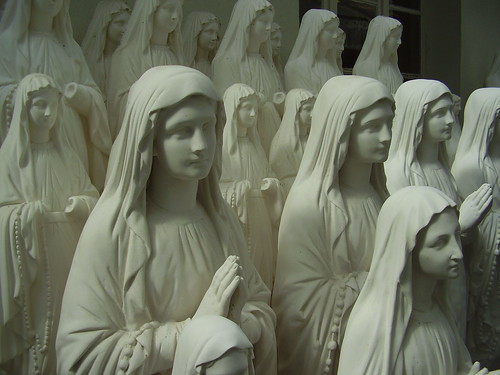
The meaning of artwork was tied to its ritualistic function, its “original use value” (SW 4:256). The cultic value assigned to these works depends on the specificity of the objects. However, technological reproduction calls this value into question. Before, it was always possible to tell the difference between originals and reproductions. Now, technology reaches a point where it is no longer an intelligible distinction. Technology assumes the same role as eternal recurrence. As Eduardo Cadava puts it, “the thought of eternal Return is a thought of technological reproducibility.”
Thought in terms of the eternal recurrence, there is no such thing as an original anything. On a systemic scale, we have no way of knowing what number recurrence we are on. Given the idea of eternal return as mass production, each event is something that has already been produced on previous cycles. In “Little History of Photography”, Benjamin speaks of “the peeling away of the object’s shell, the destruction of the aura, [as] the signature of a perception whose sense for the sameness of things has grown to the point where even the singular, the unique, is divested of its uniqueness – by means of its reproduction” (SW 2:519). Benjamin is discussing the experience of art in the wake of photography. The reproducibility of the photograph forces a change in the way all art is perceived. Even paintings or sculptures are thought of in terms of how they can be reproduced, or are approached as though they are already reproductions. Now, we can apply this perception to eternal recurrence. As a giant process re-production, eternal recurrence divests all things of their uniqueness. Nothing is new, nothing is special. Everything that happens now has already happened and will always happen. In terms of this cycle, the originality of all works crumbles. Even the original “Venus de Milo” is not the original, but rather a recurrent reproduction. There never was an original, because to be is to recur.
In light of this, it is foolish to say that technology kills art. To say that is tantamount to saying that God was alive until the late nineteenth century when Nietzsche killed him. God did not die; Nietzsche merely removed the shroud over his grave to show that he never existed at all. In the same sense, art has always been “dead”. Eternal recurrence already strips everything – not just artworks – of their uniqueness, and has done so since time immemorial. Eduardo Cadava explains it perfectly in Words of Light: “technical reproduction is not an empirical feature of modernity; it is not an invention linked to the so-called modern era. Rather, it is a structural possibility within the work of art.” Technology simply mirrors the process of eternal recurrence: in the same way that that to be is to recur, to be is to be reproducible. That is to say, reproduction does not destroy art. It merely unveils the underlying illusion in the way art is perceived.
The stripping away of the aura is not so much a stripping as it is an unveiling. Benjamin defines the aura as “a strange tissue of space and time: the unique apparition of a distance, however near it may be” (SW 2:518). Elsewhere, Benjamin states that the historical, traditional, ritualistic “aspects of the artwork” can be focused “in the concept of the aura” (SW 3:103). In other words, aura is the veil of authenticity. Authenticity is based in the “here and now of the original” (SW 4:253). It represents “the quintessence of all that is transmissible in it from its origin on, ranging from its physical duration to the historical testimony relating to it” (SW 3:103). Reproduction calls all this into question. “The whole sphere of authenticity eludes technological… reproducibility”, in that it can produce reproductions that are indistinguishable from the original, yet contain none of the traits of transmission or historicity. Rather than saying that reproduction destroys authenticity, it is more correct to say that reproduction shows the fallacy of authenticity.
“In principle, the work of art has always been reproducible”, writes Benjamin in the opening of the first thesis (SW 4:252). Before this time, however, reproductions have always been identifiable, been distinguishable from the original. In fact, Benjamin tells us, authenticity is a byproduct of reproduction technology. It is only when techniques develop to a point where they approach the original that the concept of authenticity emerges. “A medieval picture of the Madonna at the time it was created could not yet be said to be ‘authentic’”, he writes in a footnote to the artwork essay. “It became ‘authentic’ on during the succeeding centuries” (SW 4:271). Authenticity is something that gets applied after the fact, after the act of production. It arises as a response to the encroachment of new technologies onto old concepts of uniqueness. Before, authenticity could retreat to it historical, chemical, and ritualistic basis as a stronghold against the inauthentic forgeries of reproduction. The best hand reproductions and art forgeries still bare a different strain of traceable history than the original, whether it is brushstrokes, chemical composition of the material, or provenance. However, it is now possible to produce items with none of these characteristics. Benjamin’s famous example is of the photographic print. A single negative can produce an innumerable amount of identical prints; “to ask for the ‘authentic’ print makes no sense” (SW 4:256). Technical reproduction expands this beyond merely photographs. It is no longer reasonable to privilege the authentic over any other iteration of the object. Since, as Cadava points out, “the age of technical reproduction includes all of history” , it is possible to understand that this authenticity never made sense. In the realm of recurrence, nothing is authentic; everything has always been reproduced.

No comments:
Post a Comment